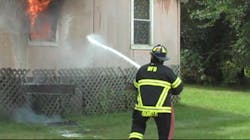Salka: Get Your *%$#$% Together!
I just watched a video of a fire department operation and was amazed at the number and severity of tactical mistakes that were captured by the camera. I am not writing about this operation to be critical of the involved department, but rather to point out the errors as a learning experience. Many fire service folks don’t or won’t criticize another department's operations so as not to hurt their feelings or reputation.
At the same time, all I keep reading about in every magazine and on every website is the need to reduce firefighter injuries and fatalities. Well folks, it’s time to make a choice. If we really want to increase the operational safety and survival of the more than 1 million firefighters in the U.S., we have to start being a little more honest with ourselves and accept criticism as a learning opportunity. Let’s get back to the fire.
There was a firefighter, without a SCBA, trying to force the entry door alone. He was not alone. In fact there were two other firefighters right there with him, both holding the charged hoseline, waiting for him to get the door open. This firefighter was simply tapping the tool against the door, somewhere near the jamb and he finally got it opened. Had one of the other firefighters simply grabbed an axe and struck the tool as he held it the door would have opened much more quickly. Remember, the fire is growing.
After the door was opened the nozzle team began to move into the structure. The nozzle firefighters simply walked up the steps and walked, upright, into the building. Of course we all know that the nozzle team should be on their knees or staying low to prevent being burned by the high heat that is found at the upper levels of the fire area. This firefighter walked in like he was going in for lunch. We all know you should be on your hands and knees to stay below the heat, the have better visibility, to locate victims lying on the floor and to avoid walking into open stairways or other unknown hazards.
After the nozzle firefighter entered the building, another walked up to the the building and broke out a window with an axe. I’m not sure why that window was selected, but as soon as the glass hit the ground, the window lit up and there was now full flames blowing out of that window. This of course was immediately followed by a hoseline being stretched to the window and opened up into the building. I’m not really happy with the random venting of the window, but let’s put that aside for now. The real problem was that the nozzle firefighter was now operating his stream into the window. Not a quick knockdown. Not 10 seconds. He opened the nozzle and worked the stream into the room. He shut down several times to reposition but then immediately opened the nozzle again and continued to direct it into the room. What’s the problem? In the background you can see the first hoseline still inside the building. We now have a nozzle team inside the building, moving toward the fire, and a second hoseline outside, directing their stream into that same building. This is called opposing streams and it rarely has good results. Opposing streams can cause the firefighters inside to suffer burns and disorientation from the smoke, heat and fire being pushed in their direction.
I must admit I didn’t watch the end of the video, but the lessons learned already made this a fire to remember. I don’t know what fire department was featured in this video and I am not here to judge them. I do, however know that the several tactics I have just described were wrong. Wrong means incorrect. In our business that could also mean dangerous or even deadly. This was a not a dramatic or once in a lifetime fire. It was a basic firefighting operation that should be handled correctly and safely by any fire department. If you want to don the gear and ride the rigs, you must be prepared to perform. Prepared to perform means train! If you are a firefighter it means attending as many drills or training sessions as you can. If you are an officer, it means preparing and delivering effective, practical and continuous training events. If you are a chief it means making sure your officers and firefighters are performing properly and if not, getting things corrected and getting your %$#%@ together!
You can contact Chief Salka at: [email protected].
